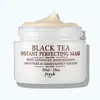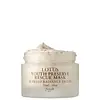What's inside
What's inside
 Key Ingredients
Key Ingredients

 Benefits
Benefits

 Concerns
Concerns

 Ingredients Side-by-side
Ingredients Side-by-side

Water
Skin ConditioningGlycerin
HumectantRice Ferment Filtrate
Skin ConditioningCaprylic/Capric Triglyceride
MaskingPentylene Glycol
Skin ConditioningSodium Polyacrylate
AbsorbentBetaine
HumectantSaccharomyces Ferment Filtrate
HumectantCamellia Sinensis Leaf Extract
AntimicrobialAvena Sativa Kernel Extract
AbrasiveVitis Vinifera Seed Oil
EmollientLitchi Chinensis Seed Extract
Skin ConditioningRubus Fruticosus Leaf Extract
MaskingRosa Damascena Flower Oil
MaskingSodium Hyaluronate
HumectantAdenosine
Skin ConditioningTocopheryl Acetate
AntioxidantTocopherol
AntioxidantEthylhexyl Palmitate
EmollientPoloxamer 407
EmulsifyingButylene Glycol
HumectantParfum
MaskingHydrogenated Lecithin
EmulsifyingMenthoxypropanediol
MaskingMaltodextrin
AbsorbentSilica
AbrasiveCI 77891
Cosmetic ColorantTrihydroxystearin
Skin ConditioningHydroxyethylcellulose
Emulsion StabilisingDisodium EDTA
Sodium Citrate
BufferingCaprylyl Glycol
EmollientCitric Acid
BufferingCaramel
Cosmetic ColorantHexylene Glycol
EmulsifyingPotassium Sorbate
PreservativeBHT
AntioxidantBiotin
AntiseborrhoeicPhenoxyethanol
PreservativeLinalool
PerfumingWater, Glycerin, Rice Ferment Filtrate, Caprylic/Capric Triglyceride, Pentylene Glycol, Sodium Polyacrylate, Betaine, Saccharomyces Ferment Filtrate, Camellia Sinensis Leaf Extract, Avena Sativa Kernel Extract, Vitis Vinifera Seed Oil, Litchi Chinensis Seed Extract, Rubus Fruticosus Leaf Extract, Rosa Damascena Flower Oil, Sodium Hyaluronate, Adenosine, Tocopheryl Acetate, Tocopherol, Ethylhexyl Palmitate, Poloxamer 407, Butylene Glycol, Parfum, Hydrogenated Lecithin, Menthoxypropanediol, Maltodextrin, Silica, CI 77891, Trihydroxystearin, Hydroxyethylcellulose, Disodium EDTA, Sodium Citrate, Caprylyl Glycol, Citric Acid, Caramel, Hexylene Glycol, Potassium Sorbate, BHT, Biotin, Phenoxyethanol, Linalool
Water
Skin ConditioningGlycerin
HumectantPropylene Glycol Dicaprylate/Dicaprate
EmollientCetearyl Alcohol
EmollientPentylene Glycol
Skin ConditioningLithothamnion Calcareum Powder
AbrasiveCaprylic/Capric Triglyceride
MaskingBetaine
HumectantNeopentyl Glycol Dicaprylate/Dicaprate
EmollientLaminaria Saccharina Extract
Skin ProtectingNelumbo Nucifera Extract
Skin ConditioningCocos Nucifera Shell Powder
AbrasiveNelumbo Nucifera Seed Powder
Skin ConditioningCitrus Limon Peel Oil
MaskingCucumis Sativus Fruit Extract
EmollientHibiscus Esculentus Fruit Extract
Skin ConditioningHelianthus Annuus Seed Oil
EmollientTocopherol
AntioxidantTocopheryl Acetate
AntioxidantPolyacrylate Crosspolymer-6
Emulsion StabilisingCetearyl Glucoside
EmulsifyingBehenyl Alcohol
EmollientCaprylyl Glycol
EmollientPotassium Cetyl Phosphate
EmulsifyingSclerotium Gum
Emulsion StabilisingCetyl Alcohol
EmollientStearyl Alcohol
EmollientCitric Acid
BufferingSodium Citrate
BufferingButylene Glycol
HumectantPropanediol
SolventSodium Polyglutamate
HumectantCaramel
Cosmetic ColorantSodium Phytate
Sodium Hydroxide
BufferingChlorphenesin
AntimicrobialSodium Metabisulfite
AntioxidantPotassium Sorbate
PreservativeSodium Benzoate
MaskingLimonene
PerfumingCitral
PerfumingWater, Glycerin, Propylene Glycol Dicaprylate/Dicaprate, Cetearyl Alcohol, Pentylene Glycol, Lithothamnion Calcareum Powder, Caprylic/Capric Triglyceride, Betaine, Neopentyl Glycol Dicaprylate/Dicaprate, Laminaria Saccharina Extract, Nelumbo Nucifera Extract, Cocos Nucifera Shell Powder, Nelumbo Nucifera Seed Powder, Citrus Limon Peel Oil, Cucumis Sativus Fruit Extract, Hibiscus Esculentus Fruit Extract, Helianthus Annuus Seed Oil, Tocopherol, Tocopheryl Acetate, Polyacrylate Crosspolymer-6, Cetearyl Glucoside, Behenyl Alcohol, Caprylyl Glycol, Potassium Cetyl Phosphate, Sclerotium Gum, Cetyl Alcohol, Stearyl Alcohol, Citric Acid, Sodium Citrate, Butylene Glycol, Propanediol, Sodium Polyglutamate, Caramel, Sodium Phytate, Sodium Hydroxide, Chlorphenesin, Sodium Metabisulfite, Potassium Sorbate, Sodium Benzoate, Limonene, Citral
 Reviews
Reviews

Ingredients Explained
These ingredients are found in both products.
Ingredients higher up in an ingredient list are typically present in a larger amount.
Betaine is a common humectant (a substance that promotes retention of moisture). It's known to be gentle on the skin and can help balance hydration.
This ingredient is best for improving hydration and soothing irritated skin. Studies also show it helps even out skin tone.
Fun fact: Betaine is naturally created in the skin and body. The kind found within cosmetic products can be either plant-derived or synthetic.
Another name for betaine is trimethylglycine.
Learn more about BetaineButylene Glycol (or BG) is used within cosmetic products for a few different reasons:
Overall, Butylene Glycol is a safe and well-rounded ingredient that works well with other ingredients.
Though this ingredient works well with most skin types, some people with sensitive skin may experience a reaction such as allergic rashes, closed comedones, or itchiness.
Learn more about Butylene GlycolThis ingredient is an emollient, solvent, and texture enhancer. It is considered a skin-softener by helping the skin prevent moisture loss.
It helps thicken a product's formula and makes it easier to spread by dissolving clumping compounds.
Caprylic Triglyceride is made by combining glycerin with coconut oil, forming a clear liquid.
While there is an assumption Caprylic Triglyceride can clog pores due to it being derived from coconut oil, there is no research supporting this.
Learn more about Caprylic/Capric TriglycerideCaprylyl Glycol is a humectant and emollient, meaning it attracts and preserves moisture.
It is a common ingredient in many products, especially those designed to hydrate skin. The primary benefits are retaining moisture, skin softening, and promoting a healthy skin barrier.
Though Caprylyl Glycol is an alcohol derived from fatty acids, it is not the kind that can dry out skin.
This ingredient is also used as a preservative to extend the life of products. It has slight antimicrobial properties.
Learn more about Caprylyl GlycolWe don't have a description for Caramel yet.
Citric Acid is an alpha hydroxy acid (AHA) naturally found in citrus fruits like oranges, lemons, and limes.
Like other AHAs, citric acid can exfoliate skin by breaking down the bonds that hold dead skin cells together. This helps reveal smoother and brighter skin underneath.
However, this exfoliating effect only happens at high concentrations (20%) which can be hard to find in cosmetic products.
Due to this, citric acid is usually included in small amounts as a pH adjuster. This helps keep products slightly more acidic and compatible with skin's natural pH.
In skincare formulas, citric acid can:
While it can provide some skin benefits, research shows lactic acid and glycolic acid are generally more effective and less irritating exfoliants.
Most citric acid used in skincare today is made by fermenting sugars (usually from molasses). This synthetic version is identical to the natural citrus form but easier to stabilize and use in formulations.
Read more about some other popular AHA's here:
Learn more about Citric AcidGlycerin is already naturally found in your skin. It helps moisturize and protect your skin.
A study from 2016 found glycerin to be more effective as a humectant than AHAs and hyaluronic acid.
As a humectant, it helps the skin stay hydrated by pulling moisture to your skin. The low molecular weight of glycerin allows it to pull moisture into the deeper layers of your skin.
Hydrated skin improves your skin barrier; Your skin barrier helps protect against irritants and bacteria.
Glycerin has also been found to have antimicrobial and antiviral properties. Due to these properties, glycerin is often used in wound and burn treatments.
In cosmetics, glycerin is usually derived from plants such as soybean or palm. However, it can also be sourced from animals, such as tallow or animal fat.
This ingredient is organic, colorless, odorless, and non-toxic.
Glycerin is the name for this ingredient in American English. British English uses Glycerol/Glycerine.
Learn more about GlycerinPentylene glycol is typically used within a product to thicken it. It also adds a smooth, soft, and moisturizing feel to the product. It is naturally found in plants such as sugar beets.
The hydrophilic trait of Pentylene Glycol makes it a humectant. As a humectant, Pentylene Glycol helps draw moisture from the air to your skin. This can help keep your skin hydrated.
This property also makes Pentylene Glycol a great texture enhancer. It can also help thicken or stabilize a product.
Pentylene Glycol also acts as a mild preservative and helps to keep a product microbe-free.
Some people may experience mild eye and skin irritation from Pentylene Glycol. We always recommend speaking with a professional about using this ingredient in your routine.
Pentylene Glycol has a low molecular weight and is part of the 1,2-glycol family.
Learn more about Pentylene GlycolPotassium Sorbate is a preservative used to prevent yeast and mold in products. It is commonly found in both cosmetic and food products.
This ingredient comes from potassium salt derived from sorbic acid. Sorbic acid is a natural antibiotic and effective against fungus.
Both potassium sorbate and sorbic acid can be found in baked goods, cheeses, dried meats, dried fruit, ice cream, pickles, wine, yogurt, and more.
You'll often find this ingredient used with other preservatives.
Learn more about Potassium SorbateSodium Citrate is the sodium salts of citric acid. In skincare, it is used to alter pH levels and acts as a preservative.
Its main functions are to maintain the pH of a product and neutralize metal ions.
The acidity of our skin is maintained by our glands and skin biome; normal pH level of skin is slightly acidic (~4.75-5.5).
Being slightly acidic allows our skin to create an "acid mantle". This acid mantle is a thin barrier that protects our skin from bacteria and contaminants.
Learn more about Sodium CitrateTocopherol (also known as Vitamin E) is a common antioxidant used to help protect the skin from free-radicals and strengthen the skin barrier. It's also fat soluble - this means our skin is great at absorbing it.
Vitamin E also helps keep your natural skin lipids healthy. Your lipid skin barrier naturally consists of lipids, ceramides, and fatty acids. Vitamin E offers extra protection for your skin’s lipid barrier, keeping your skin healthy and nourished.
Another benefit is a bit of UV protection. Vitamin E helps reduce the damage caused by UVB rays. (It should not replace your sunscreen). Combining it with Vitamin C can decrease sunburned cells and hyperpigmentation after UV exposure.
You might have noticed Vitamin E + C often paired together. This is because it is great at stabilizing Vitamin C. Using the two together helps increase the effectiveness of both ingredients.
There are often claims that Vitamin E can reduce/prevent scarring, but these claims haven't been confirmed by scientific research.
Learn more about TocopherolTocopheryl Acetate is AKA Vitamin E. It is an antioxidant and protects your skin from free radicals. Free radicals damage the skin by breaking down collagen.
One study found using Tocopheryl Acetate with Vitamin C decreased the number of sunburned cells.
Tocopheryl Acetate is commonly found in both skincare and dietary supplements.
Learn more about Tocopheryl AcetateWater. It's the most common cosmetic ingredient of all. You'll usually see it at the top of ingredient lists, meaning that it makes up the largest part of the product.
So why is it so popular? Water most often acts as a solvent - this means that it helps dissolve other ingredients into the formulation.
You'll also recognize water as that liquid we all need to stay alive. If you see this, drink a glass of water. Stay hydrated!
Learn more about Water